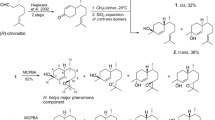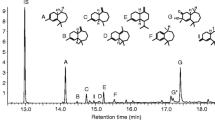Abstract
Laboratory bioassays indicated that frass produced byGnathotrichus retusus males and male gut extracts were attractive to both sexes of beetles. The frass became attractive to females within 2 days of the commencement of boring activity, and attractive frass was produced for at least lOdays. Attraction of frass rose sharply after pairing of males with females. However, this increase in attraction could be due to increased boring activity and pheromone production by males following establishment of the mutualistic fungus. In field trapping experiments, male-infested logs were always highly attractive, but in one experiment, female-infested logs and logs infested by both sexes were also attractive. Thus, females could be involved in secondary attraction. High cross-attraction ofG. sulcatus toG. retusus infested logs in field experiments, as well as a moderate but significant response byG. retusus to sulcatol in the laboratory, suggests that they share sulcatol as a common pheromone.
Similar content being viewed by others
References
Borden, J.H., andStokkink, E. 1973. Laboratory investigation of secondary attraction inGnathotrichus sulcatus (Coleoptera: Scolytidae).Can. J. Zool. 51:469–473.
Borden, J.H.,VanderSar, T.J., andStokkink, E. 1975. Secondary attraction in the Scolytidae: An annotated bibliography. Simon Fraser Univ. Pest Mgt. Pap. No. 4. 97 pp.
Borden, J.H., Chong, L., McLean, J.A., Slessor, K.N., andMori, K. 1976.Gnathotrichus sulcatus: Synergistic response to enantiomers of the aggregation pheromone sulcatol.Science 28:894–896.
Brand, J.M., andBarras, S.J. 1977. The major volatile constituents of a basidiomycete associated with the southern pine beetle.Lloydia 40:398–400.
Brand, J.M., Schultz, J., Barras, S.J., Edson, L.J., Payne, T.L., andHedden, R.L. 1977. Bark beetle pheromones: Enhancement ofDendroctonus frontalis (Coleoptera: Scolytidae) aggregation pheromone by yeast metabolites in laboratory bioassays.J. Chem. Ecol. 3:657–666.
Byrne, K.E., Swigar, A., Silverstein, R.M., Borden, J.H., andStokkink, E. 1974. Sulcatol: Population aggregation pheromone inGnathotrichus sulcatus (Coleoptera: Scolytidae).J. Insect Physiol. 20:1895–1900.
Cade, S.C. 1970. The host selection behavior ofGnathotrichus sulcatus LeConte (Coleoptera: Scolytidae). PhD thesis, University of Washington. 112 pp.
Chapman, J.A. 1966. The effect of attack by the ambrosia beetleTrypodendron lineatum (Olivier) on log attractiveness.Can. Entomol. 98:50–59.
Johnson, N.E. 1958. Field identification of ambrosia beetles attacking coniferous timber in the Douglas-fir region.Can. Entomol 90:236–240.
Kinzer, G. W., Fentiman, A.F., Jr., Page, T.F., Jr., Foltz, R.L., Vité, J.P., andPitman, G.B. 1969. Bark beetle attractants: Identification, synthesis and field bioassay of a new compound isolated fromDendroctonus.Nature (London) 221:477–478.
MacConnell, J.G., Borden, J.H., Silverstein, R.M., andStokkink, E. 1977. Isolation and tentative identification of lineatin, a pheromone from the frass ofTrypodendron lineatum (Coleoptera: Scolytidae).J. Chem. Ecol. 3:551–563.
McLean, J.A., andBorden, J.H. 1975. Survey of a sawmill population ofGnathotrichus sulcatus (Coleoptera: Scolytidae) using the pheromone, sulcatol.Can. J. For. Res. 5:586–591.
McLan, J.A., andBorden, J.H. 1977a. Attack byGnathotrichus sulcatus (Coleoptera: Scolytidae) on stumps and felled trees baited with sulcatol and ethanol.Can. Entomol. 109:675- 686.
MeLean, J.A., andBorden, J.H. 1977b. Suppression ofGnathotrichus sulcatus with sulcatolbaited traps in a commercial sawmill and notes on the occurrence ofG. retusus andTrypodendron lineatum.Can. J. For. Res. 7:348–356.
Rudinsky, J.A., andDaterman, G.E. 1964a. Response of the ambrosia beetleTrypodendron lineatum (Oliv.) to a female-produced pheromone.Z. Angew. Entomol. 54:300–303.
Rudinsky, J.A., andDaterman, G.E. 1964b. Field studies on flight patterns and olfactory responses of ambrosia beetles in Douglas-fir forests of western Oregon.Can. Entomol. 96:1339–1352.
Silverstein, R.M., Brownlee, R.G., Bellas, T.E., Wood, D.L., andBrowne, L.E. 1968. Brevicomin: Principal sex attractant in the frass of the female western pine beetle.Science 159:889–890.
Author information
Authors and Affiliations
Additional information
Research supported by Canadian Forestry Service Science Subvention Grant, National Research Council of Canada Operating Grant No. A3881, National Science Foundation (U.S.A.) Operating Grant No. PCM74-13643-A02, and the Council of Forest Industries of British Columbia.
Rights and permissions
About this article
Cite this article
Borden, J.H., McLean, J.A. Secondary attraction inGnathotrichus retusus and cross-attraction ofG. sulcatus (Coleoptera: Scolytidae). J Chem Ecol 5, 79–88 (1979). https://doi.org/10.1007/BF00987689
Received:
Revised:
Issue Date:
DOI: https://doi.org/10.1007/BF00987689




